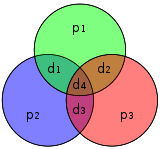Hamming(7,4)
| Hamming(7,4)-Code | |
|---|---|
 |
|
| Named after | Richard W. Hamming |
| Classification | |
| Type | Linear block code |
| Block length | 7 |
| Message length | 4 |
| Rate | 4/7 ~ 0.571 |
| Distance | 3 |
| Alphabet size | 2 |
| Notation | [7,4,3]2-code |
| Properties | |
| perfect code | |
In coding theory, Hamming(7,4) is a linear error-correcting code that encodes four bits of data into seven bits by adding three parity bits. It is a member of a larger family of Hamming codes, but the term Hamming code often refers to this specific code that Richard W. Hamming introduced in 1950. At the time, Hamming worked at Bell Telephone Laboratories and was frustrated with the error-prone punched card reader, which is why he started working on error-correcting codes.
The Hamming code adds three additional check bits to every four data bits of the message. Hamming's (7,4) algorithm can correct any single-bit error, or detect all single-bit and two-bit errors. In other words, the minimal Hamming distance between any two correct codewords is 3, and received words can be correctly decoded if they are at a distance of at most one from the codeword that was transmitted by the sender. This means that for transmission medium situations where burst errors do not occur, Hamming's (7,4) code is effective (as the medium would have to be extremely noisy for two out of seven bits to be flipped).
The goal of the Hamming codes is to create a set of parity bits that overlap such that a single-bit error (the bit is logically flipped in value) in a data bit or a parity bit can be detected and corrected. While multiple overlaps can be created, the general method is presented in Hamming codes.
This table describes which parity bits cover which transmitted bits in the encoded word. For example, p2 provides an even parity for bits 2, 3, 6, and 7. It also details which transmitted bit is covered by which parity bit by reading the column. For example, d1 is covered by p1 and p2 but not p3 This table will have a striking resemblance to the parity-check matrix (H) in the next section.
Furthermore, if the parity columns in the above table were removed
...
Wikipedia
